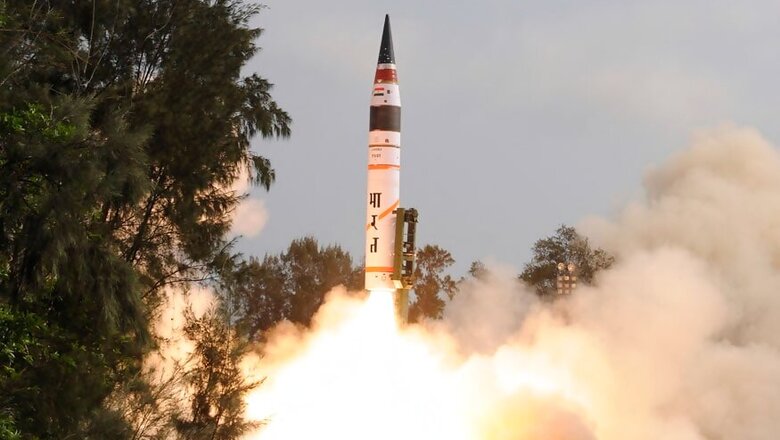
views
Odisha: India on Monday test fired surface-to-surface nuclear capable ballistic missile 'Agni-5' from Abul Kalam Island off the coast of Odisha on Monday.
The reports further suggest that this will be the fourth and final test of intercontinental ballistic missile Agni-5.
The missile is capable of reaching northern parts of China.
The surface-to-surface missile developed by DRDO is capable of striking a target more than 5,000 km away.
The missile is about 17-metre long, 2-metre wide and has launch weight of around 50 tonnes.
Defence sources said that the successful test-firing will pave the way for user trial of the most potent Indian missile and its eventual induction into the special forces command (SFC).
The three-stage, solid propellant surface-to-surface missile was test-fired from a mobile launcher from launch complex-4 of the Integrated Test Range (ITR) at about 1105 hours, DRDO sources said.
The high speed on board computer and fault tolerant software along with robust and reliable bus guided the Missile flawlessly, said a DRDO official.
The missile is so programmed that after reaching peak of its trajectory, it turns towards earth to continue its journey towards the intended target with an increased speed due to the attraction of earths gravitational pull and its path precisely directed by the advanced on-board computer and inertial navigation system.
The atmospheric air rubbing the skin of the missile during the re-entry phase raises the temperature to beyond 4000 degree Celsius.
However, the indigenously designed and developed carbon-carbon composite heat shield continues to burn sacrificially protecting the payload, maintaining the inside temperature below 50 degree Celsius.Read More: Agni-5: 10 Things to Know About the Nuclear-capable Missile
It is the fourth developmental and second canisterised trial of the missile. While the first test was conducted on April 19, 2012, the second was on September 15, 2013 and the third on January 31, 2015 from the same base.
The missile can carry a nuclear warhead of more than one tonne.
Unlike other missiles of Agni series, the latest one 'Agni-5' is the most advanced having some new technologies incorporated with it in terms of navigation and guidance, warhead and engine.
A Lot of new technologies developed indigenously were successfully tested in the first Agni-5 trial.
The very high accuracy Ring Laser Gyro based Inertial Navigation System (RINS) and the most modern and accurate Micro Navigation System (MINS) had ensured the Missile reach the target point within few metres of accuracy.
India has at present in its armoury of Agni series, Agni-1 with 700 km range, Agni-2 with 2,000 km range, Agni-3 and Agni-4 with with 2,500 km to more than 3500 km range.
(With PTI inputs)




















Comments
0 comment